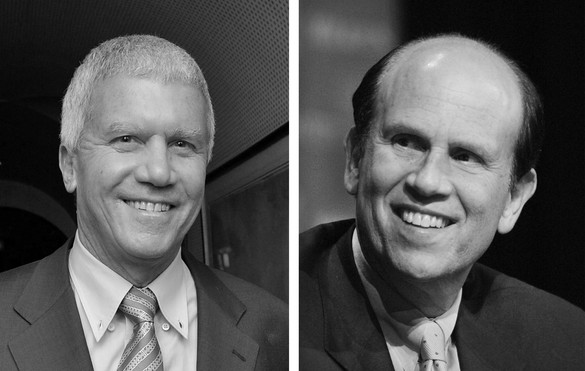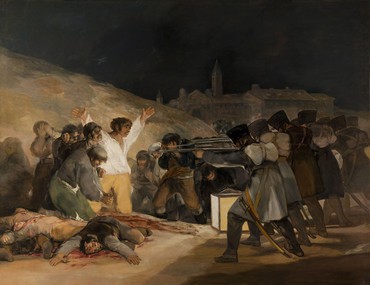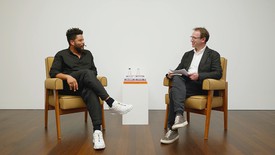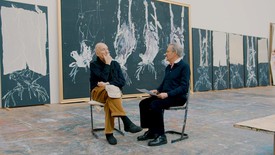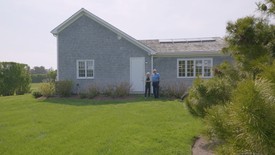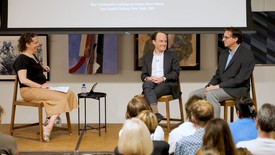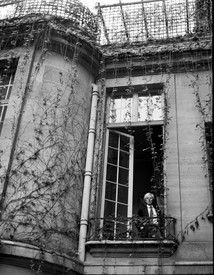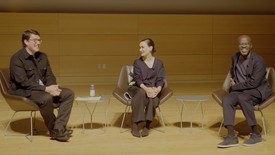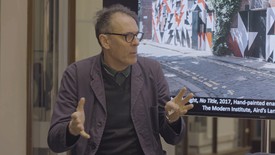
Mike Milken is chairman of the Milken Institute. Fifteen years ago Fortune magazine called him “The Man Who Changed Medicine.” Now, after five decades of advancing medical solutions, the financier/philanthropist faces his greatest career challenge in COVID-19. Early in 2020 he redeployed all ten centers of the Institute to help expedite treatments and vaccines. Photo: Bloomberg via Getty Images
In support of vital efforts to address the critical challenges we face today, from the devastating impacts of COVID-19 to the urgent need for progressive change in matters of racial justice, Gagosian has partnered with the nonprofit think tank Milken Institute to provide funding for key initiatives, from fast-tracking a cure for the virus to addressing racial inequities in medical access and treatment.
In June Larry Gagosian invited gallery artists to join him in donating proceeds from sales of works presented during Art Basel Online to support the Milken Institute’s programs. The response was overwhelming, with donations being made by Katharina Grosse, Jennifer Guidi, Hao Liang, Jia Aili, Albert Oehlen, Sterling Ruby, Ed Ruscha, Spencer Sweeney, Sarah Sze, Tatiana Trouvé, and Mary Weatherford.
The Milken Institute’s initiatives cut across a broad range of crucial areas. They include FasterCures, which is accelerating biomedical research and treatments for patients while working to mobilize a cure for COVID-19. The Prostate Cancer Foundation, established in 1993, has partnered with the US Department of Veteran’s Affairs to address the disparities in health outcomes related to this disease in the US, where Black men, compared with men of any other race or ethnicity, are 76% more likely to develop prostate cancer and 2.4 times more likely to die as a result. In 2023 the institute’s Center for Advancing the American Dream, which works to expand access to health, education, and economic opportunity, will open a visitor center on Pennsylvania Avenue in Washington, DC, across from the White House and the Treasury Building, to welcome students, educators, families, and tourists from around the world to participate in interactive, immersive learning experiences.
Mike Milken and Larry Gagosian spoke in early June 2020.
Mike MilkenLarry, we were both born in Los Angeles. I was a San Fernando Valley boy. You and I went to the same high school, though we didn’t know each other back then. When I think of Los Angeles today, during these protests, it reminds me of 1965. I came home from Berkeley during that summer, to work in LA, and on August 11 the Watts riots broke out. Looking at all the young people who are peacefully protesting right now, it takes me back to that night, when I wanted to go into South Central LA and try to find out what was happening. My dad wouldn’t allow it, so I waited until the morning, told them I was going to see a friend, and drove down. What do you remember about that moment?
Larry Gagosian In 1965 I was at UCLA, and the Watts riots had a similar impact on me. The intensity and scope of it was beyond anything that I had ever seen or experienced. I’ll never forget it. It’s interesting that you bring it up; you and I have never talked about it before.
MMWhen I think of young people today, I think of you and I and what our reaction was back then and what their reaction is today. Art plays a more important role than ever during a crisis. Are there moments in history that you think are well represented by iconic paintings or photographs? Where the artworks—just by looking at them, without any captions or other clues—capture the spirit of the time?
it is impossible for me to imagine that the world can continue to be built without sharing, without equity, without justice that is medical, social, but also ecological and cognitive. It is for this reason that I have supported the work of the Milken Institute.
Tatiana Trouvé
LGPhotography, obviously, is the most vivid way of capturing history. Going back to photographs that were taken during the Civil War, that were taken during World War I, that were taken at the Battle of Dunkirk—I mean, photography is immediate and irrefutable in the message it conveys. Whereas painting—in my opinion, a painter often needs time to reflect on an event, to take it in and process it, maybe not even consciously. It’s often filtered through other experiences and craft, and for me, that’s when it’s most meaningful. Over the years many great artists have dealt with the tragedies and the turmoil of the time they’ve lived in.
Picasso made an amazing painting in response to the Korean War [Massacre in Korea, 1951]. Most people know Guernica [1937], but fewer people remember this painting. It’s a very unusual Picasso, because it’s very literal. You see soldiers lined up with long rifles. Picasso borrowed the imagery from a Goya painting [The Third of May 1808 in Madrid, 1814], and put it into his present context. He had very strong political views, particularly in terms of what was going on in Spain, but he wasn’t a political painter.
MMI know you interact with many artists. Have you had many discussions with them since the outbreak of coronavirus?
LGI haven’t physically visited with any artists. I’ve been pretty strict about my protocol in isolation. But I’ve talked to many of the artists that I represent—in part about what is going on in the world, and more about how they are feeling, what’s their mood, are they working? You know, artists tend to work in isolation—I mean, some artists have studio assistants but many artists work by themselves, and right now they are still going to a studio and trying to work. I wouldn’t say it’s an escape, but for many of them I think the enforced isolation, knowing that they don’t really have access to the broader world in the same way, concentrates them in a particular way.
Things may have shut down, but as a dealer, representing these incredible artists, I take it as a very serious responsibility to keep the ball rolling for the artists who depend on me for their livelihood.
In such uncertain times, scientific biomedical research has never been more important. I am happy to contribute to the Milken Institute’s steadfast efforts during this pandemic to fast track a cure and to support equality in medicine.
Sterling Ruby
MMIn my career, I was always looking for that next entrepreneur to back financially: Who had a vision of a new industry? Who viewed the world differently? When I think of your career, the amazing ability you’ve had to look at new artists . . . Take us back for a moment to the beginning, from being a young student at UCLA to deciding that art was your career.
LGI didn’t have a career path when I graduated from UCLA. I didn’t have a lot of drive or ambition. It took me six years to graduate, because I took a hiatus a couple of times. But I got my diploma and then I started parking cars for a living. I was parking cars in Westwood Village, and making enough money to get by. Then I saw somebody selling posters on the sidewalk, and I thought, “Wow, maybe I could sell posters.” So I found out where this guy bought his posters. My family didn’t collect art. We didn’t go to museums. I didn’t come from that kind of a cultural background. I wish I had. I was an English major. I didn’t study business or art history, but luckily—and I mean, it’s got to be Luck with a capital L—I started selling posters and I found out that I was a decent salesman. I got a little frame shop so I could get off the sidewalk, and everything kind of went the right way and snowballed.
I remember my first trip to New York was to go to an artist’s studio. I’d never been to New York, and I fell in love with it. I was smitten as soon as I hit the sidewalk. And so New York and art became fused at that moment in my life.
MMWhat about identifying artists you want to work with? Is it a feeling that their work is going to connect to someone else?
LGWell, I don’t think about it connecting to someone else so much. The main criteria for me is, Do I think it’s significant? Do I think it’s interesting? Do I think it’s innovative? It should not be a rehash of what some other artist did. I have a pretty good eye for art, and I think I’m right more often than wrong. If it turns me on, very often there will be an audience for it.
To me, encountering a new artist, a young artist, somebody I wasn’t familiar with who I think has exceptional talent, is still one of the most exciting things in my business. It doesn’t come along every day. Just to give you a quick example, I was living in my loft in New York in the early eighties and a friend of mine, Barbara Kruger, a terrific artist and a great friend, was in a group show in a gallery. I walked over to see her work, and in the next room I saw these paintings, I think there were five of them, if I’m not mistaken, and my hair stood up. I got goosebumps. It was that exciting and impactful. Annina Nosei, who owned the gallery, came out to greet me. I said, “Annina, this is unbelievable. Who is this artist?” And she said, “Oh, it’s Jean-Michel Basquiat. You haven’t heard of him?” I bought three of the paintings, walked into her office, and there was Jean-Michel Basquiat. And we became friends.
Art is the light of the spirit. It enlightens the dust of the mind.
Jia Aili
MMHow do you make a decision about where to open one of your galleries?
LGWell, some of my choices for cities are kind of obvious. London is the capital for art in Europe. Now I have three galleries there. I have two galleries in Paris and a gallery in Rome, a gallery in Geneva. We were the first Western gallery to open in Hong Kong. That has been absolutely game-changing for my business because Hong Kong is the gateway to Asia in terms of commerce and banking and finance. Many art collectors in Asia transact there, so that’s been a great platform for us. And of course there is LA, where I started. When I first moved to New York it was pretty much full time, so I closed my gallery in LA because I couldn’t really handle having two galleries back then. I didn’t have the wherewithal to do that at that moment. But when I felt more confident about my business, I wanted to open a gallery in LA. Richard Meier designed the gallery that I opened on Camden Drive in Beverly Hills. It’s a beautiful, beautiful gallery. God, that’s well over twenty years ago. It’s challenging every day in different ways, but somehow it suits me to have this kind of a business.
MMOne of the things I’ve noticed about your galleries around the world is that they are an expression themselves: the environment, the light, and so on. How involved are you in the structure of the galleries?
LGI’m quite involved. Obviously, I’m not an architect; I’m not involved at that level. But I do pick the architects and I’m very involved with the design of the spaces. It’s very important for painters and sculptors to have a space with good light, that has good volumes, and that’s physically attractive to show their work. People come into the galleries to see art and to buy art. And the experience they have, the attractiveness of the space—you could take the same art and put it in an awkward location that doesn’t have good light and it will look totally different and won’t be as compelling for the public or the collector. In Paris it took me three years to find the space. In Rome it took me two years. I often look at many possibilities before finding the right space, the right location.
Things may have shut down, but as a dealer, representing these incredible artists, I take it as a very serious responsibility to keep the ball rolling.
Larry Gagosian
MMMore and more, recently, you’ve been presenting art digitally. How did this idea get started?
LGIt’s largely out of necessity. We had to figure out a way to keep our artists in the public eye and make sales. We’ve come up with various online strategies over the past few years, and we’ve done extremely well. When the shutdown happened, all the artists we were going to show during this period, their shows got canceled, which is very frustrating and very costly for that artist. When things get back to normal—whenever that is, hopefully soon—a lot of these online strategies will stay part of our business.
MMOne of the artists you represent was recently on the cover of Time magazine.
LGYes, Titus Kaphar. He’s a really talented artist and very much speaking to what’s going on right now. The cover of Time magazine depicts a Black woman holding her baby. Except the baby has been removed from the painting. It’s a powerful expression of loss. He gave a talk at a conference recently for about half an hour and I’ve never seen an artist hold an audience like that. We’re going to be showing his work in New York once we are able to reopen.
MMLarry, thank you for joining me today. I always learn a great deal when I speak to you about art and life.
LGThank you, Mike. Great to spend some time with you today.
This is an edited excerpt of a longer conversation, which can be heard in full as part of the “Conversations with Mike Milken” podcast series, produced by the Milken Institute
For more on the Milken Institute’s work around COVID-19, visit mikemilken.com
